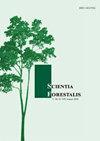基于主成分分析的柚木人工林RapidEye影像光谱变量与树形变量的关系
IF 0.4
4区 农林科学
Q4 FORESTRY
引用次数: 1
摘要
通过分析技术和大规模人工林的程序,越来越多地利用地质技术信息来监测林分。本研究利用RapidEye卫星影像,利用植被指数对光谱变量、树木学变量和柚木人工林均匀度指数之间的关系进行主成分分析。该试验于2015年实施,分布在12个实验单元,每个实验单元测量50棵树。野外数据来自2019年5月进行的森林清查,当时收集了所有树木的总高度(ht)和1.30 m高度(dbh)的直径数据。植被指数与均匀度指数之间呈显著负相关。主成分分析表明,RapidEye图像光谱变量与树木学变量的主成分分析可以区分柚木人工林的均匀性。林业科学,49(132),e3655,2021 2/11非均匀性。因此,可以通过RapidEye卫星的树形变量和光谱变量之间的相关性来预测柚木林的均匀性。本文章由计算机程序翻译,如有差异,请以英文原文为准。
Relationship between spectral variables with RapidEye images and dendrometric variables in teak plantations using principal component analysis
Geo-technological information is increasingly used to monitor forest stands through analytical techniques and procedures for large-scale plantations. The objective of this study was to evaluate the relationship between spectral variables (through vegetation index) using images from the RapidEye satellite, dendrometric variables and the uniformity index in teak plantations by applying principal component analysis. The experiment was implemented in 2015, distributed in 12 experimental units, and 50 trees were measured per unit. The field data were obtained from the forest inventory carried out in May 2019, when data on total height (ht) and diameter at 1.30 m height (dbh) of all trees were collected. A strong negative correlation was observed between vegetation indexes and dendrometric variables with uniformity index. The main component analysis indicated the possibility of differentiating uniform from Relationship between spectral variables with RapidEye images and dendrometric variables in teak plantations using principal component analysis Scientia Forestalis, 49(132), e3655, 2021 2/11 non-uniform plantations. Therefore, it is possible to predict uniformity in teak stands through the correlation between dendrometric variables and spectral variables from the RapidEye satellite.
求助全文
通过发布文献求助,成功后即可免费获取论文全文。
去求助
来源期刊

Scientia Forestalis
Agricultural and Biological Sciences-Forestry
CiteScore
1.00
自引率
0.00%
发文量
39
期刊介绍:
Scientia Forestalis is a scientific publication of the IPEF – Institute of Forest Research and Studies, founded in 1968, as a nonprofit institution, in agreement with the LCF – Department of Forest Sciences of the ESALQ – Luiz de Queiroz College of Agriculture of the USP – São Paulo University. Scientia Forestalis, affiliated to the ABEC – Brazilian Association of Scientific Publishers, publishes four issues per year of original papers related to the several fields of the Forest Sciences.
The Editorial Board is composed by the Editor, the Scientific Editors (evaluating the manuscript), and the Associated Editors (helping on the decision of acceptation or not of the manuscript, analyzed by the Peer-Reviewers.
 求助内容:
求助内容: 应助结果提醒方式:
应助结果提醒方式:


